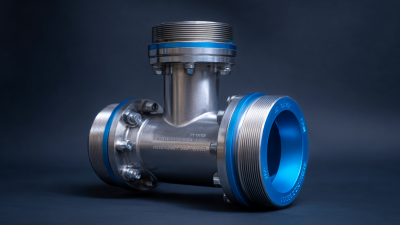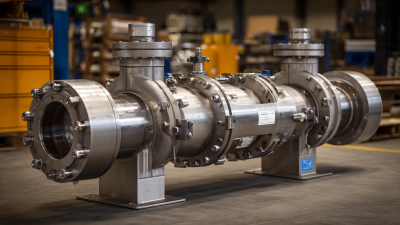Ultimate Checklist for Choosing the Right PTFE Valve for Your Industrial Needs
 When it comes to industrial applications, selecting the right PTFE valve is crucial for ensuring efficiency and safety in your processes. With a myriad of options available, understanding the essential features and specifications of PTFE valves can be overwhelming. This ultimate checklist will guide you through the key factors to consider, from compatibility with your specific media to the operating conditions of your system.
When it comes to industrial applications, selecting the right PTFE valve is crucial for ensuring efficiency and safety in your processes. With a myriad of options available, understanding the essential features and specifications of PTFE valves can be overwhelming. This ultimate checklist will guide you through the key factors to consider, from compatibility with your specific media to the operating conditions of your system.
Whether you’re dealing with corrosive substances or high-temperature environments, knowing how to evaluate different PTFE valve options will help you make an informed decision that meets your unique requirements. By following this comprehensive guide, you’ll gain the insights necessary to choose a PTFE valve that not only enhances performance but also contributes to the long-term reliability of your industrial operations.
Understanding PTFE Valves: Key Features and Benefits for Industrial Applications
When it comes to industrial applications, choosing the right PTFE valve is crucial for ensuring operational efficiency and longevity. PTFE, or polytetrafluoroethylene, is renowned for its excellent chemical resistance and durability, making it an ideal material for valves exposed to harsh conditions. The key features of PTFE valves include their ability to withstand high temperatures, non-stick properties, and resistance to corrosion and wear. These characteristics help prevent leaks and reduce maintenance costs, aligning perfectly with the needs of various industries, such as chemical processing and pharmaceuticals.

The growing market for PTFE-lined valves indicates a robust demand, projected to rise from $64.14 million in 2024 to $84.01 million by 2032, reflecting a compound annual growth rate of 3.4%. This growth can be attributed to the increasing adoption of advanced materials in industrial processes. As industries prioritize safety and efficiency, the right PTFE valve can play a pivotal role in achieving these goals. Understanding the specific requirements of your application—including pressure, flow rates, and chemical compatibility—will ultimately guide you in selecting a PTFE valve that meets your operational needs effectively.
Identifying Your Industrial Needs: Factors to Consider When Choosing a Valve
Choosing the right PTFE valve for your industrial needs requires a comprehensive understanding of your specific applications and requirements. When evaluating options, consider the valve's compatibility with the materials involved. PTFE valves are known for their resistance to chemicals and extreme temperatures, making them a suitable choice for industries such as pharmaceuticals, chemicals, and food processing. In fact, the PTFE-lined plug valve market is projected to grow from $64.14 million in 2024 to $84.01 million by 2032, reflecting a steady growth rate of 3.4%. This highlights the increasing demand for reliable valves that can withstand corrosive environments.

Furthermore, assessing the operational environment is critical. Factors such as pressure, flow rates, and temperature variations must align with the specifications of the valve you choose. Various applications, including water treatment and semiconductor fabrication, have unique requirements, emphasizing the need for precise valve selection to ensure optimum performance and longevity. Consulting industry reports can provide insights into prevalent trends and evolving technologies, enabling you to make well-informed decisions tailored to your industrial needs.
Comparative Analysis: PTFE Valves vs. Other Valve Materials
When it comes to selecting valves for industrial applications, material choice is crucial, and PTFE (Polytetrafluoroethylene) valves offer significant advantages over traditional options. Unlike metal valves, PTFE valves provide superior resistance to corrosion and chemical attack, making them ideal for industries dealing with aggressive substances. This characteristic not only extends their lifespan but also enhances operational safety. In a comparative analysis, PTFE valves stand out for their ability to maintain integrity in extreme temperatures and pressures, where other materials may fail or require more frequent replacements.
Recent market forecasts highlight a growing interest in PTFE-lined valves, predicting a revenue increase from $6.414 million in 2024 to $8.401 million by 2032, reflecting a 3.4% annual growth rate. This upward trend underscores the increasing adoption of PTFE valves across various sectors, driven by their reliability and performance advantages. Additionally, as manufacturers seek to meet high standards for safety and efficiency, the demand for valves that can withstand harsh environments continues to rise, positioning PTFE as the preferred choice for many industrial applications.
Installation and Maintenance Tips for PTFE Valves to Enhance Longevity
When it comes to PTFE valves, proper installation and maintenance are crucial to maximizing their lifespan and performance in industrial applications. First and foremost, ensure that the valve is installed correctly, paying close attention to the alignment and tightening of all connections. Using the appropriate tools and avoiding excessive force can help prevent damage to the valve material. Additionally, it is essential to follow the manufacturer's specifications regarding the installation torque to maintain the integrity of the PTFE seals.
Regular maintenance is equally important for extending the longevity of PTFE valves. A recommended practice is to routinely inspect the valves for any signs of wear or leakage, as early detection can prevent more significant issues down the line. Cleaning the valves with compatible solvents and ensuring that no debris obstructs their operation will also enhance their efficiency. Moreover, keeping a maintenance log can help track the performance of the valves over time, allowing for proactive servicing and, if necessary, timely replacement. By incorporating these installation and maintenance tips, industries can significantly enhance the performance and durability of PTFE valves in their operations.
Performance Comparison of Different PTFE Valve Types
This bar chart illustrates the performance ratings of various PTFE valve types utilized in industrial applications. Ratings are based on their effectiveness in controlling flow and minimizing leakage. As observed, the Butterfly Valve tends to perform the highest, while the Check Valve ranks lower in performance. Select the type of PTFE valve that best suits your installation and maintenance requirements.
Common Misconceptions About PTFE Valves in Industrial Settings
When it comes to selecting PTFE valves for industrial applications, there are several misconceptions that can lead to poor decision-making. One prevalent myth is that all PTFE valves are the same, disregarding the significance of their specific designs and functionalities. In reality, the performance of PTFE valves can vary widely based on factors such as construction materials, pressure ratings, and the type of sealing mechanisms used. Each application demands careful consideration of these parameters to ensure optimal operational efficiency and longevity.
Another common misunderstanding is regarding the maintenance and durability of PTFE valves. Some operators believe that PTFE valves are less reliable compared to traditional materials; however, the market is witnessing a growing recognition of the benefits offered by PTFE. With an anticipated market value of $64.14 million in 2024 and a projected rise to $84.01 million by 2032, expanding at a growth rate of 3.4%, it’s clear that industries are recognizing the superior chemical resistance and thermal stability that PTFE valves provide. Addressing these misconceptions can guide users toward making more informed choices that enhance their industrial processes.
Related Posts
-

Unmatched Excellence in PTFE Lined Check Valves: Crafted in China, Delivered Worldwide
-

Mastering BFV Valves: A Comprehensive Tutorial on Selection, Sizing, and Optimization Techniques
-

5 Essential Tips for Choosing the Right Lined Valves for Your Industrial Needs
-

Understanding Industry Standards for the Best Actuator Valve and How to Choose the Right One
-

Understanding the Benefits and Applications of Lockable Ball Valves in Industrial Settings
-

Mastering Ball Valve Selection: A Comprehensive Tutorial for Optimal Flow Control in Industrial Applications
